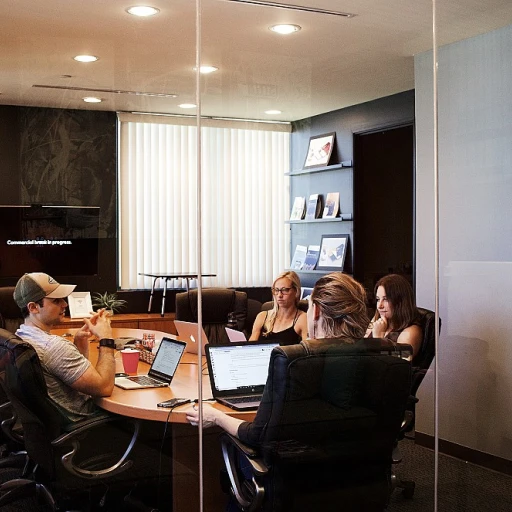Understanding Company Vision and Strategy
Connecting with Company Purpose
Understanding the company's vision and strategy is the backbone of any successful engagement with senior management. As a starting point, it's crucial to comprehend the long-term goals and values that drive the organization. Establishing a clear understanding of the company's strategic direction can significantly influence your role within the team and career growth opportunities. Engaging with senior executives often requires well-prepared interviews and strategic questions. Questions demonstrate your interest in the company's mission and show leadership that you're keen to align your efforts with theirs. Here are a few essential topics to consider:- Vision and Strategic Planning: What are the key strategic objectives the organization aims to achieve? How do these align with the current company culture and initiatives?
- Leadership Style: How do senior leaders view their leadership style in successfully driving the company forward? Understanding this can help you better align your approach and expectations.
- Innovation and Digital Transformation: What role does innovation play in the company's future plans? Discussing digital transformation could offer insights into upcoming projects and the direction the company is moving in.
Navigating Cultural Nuances in New Zealand
Cultural Awareness and Adaptation
Engaging with senior management in New Zealand requires an understanding of the cultural nuances that influence leadership styles and decision-making processes. While some traits may be universally held by leaders worldwide, New Zealand's unique cultural characteristics necessitate a tailored approach. New Zealand organizations often value inclusivity and egalitarianism, which can shape how leaders engage with team members. Respecting the local culture by adopting a warm, informal communication style can help foster a more productive relationship with senior leaders. Furthermore, participating in cultural traditions or acknowledging the importance of local events may enhance your rapport with executives. When preparing for meetings or interviews with senior management, consider how cultural understanding can inform your strategic planning and career growth within the company. Explore effective communication tools beyond email to align better with regional expectations and improve employee engagement. Here are a few strategic questions you might pose to senior executives to strengthen this understanding:- How does the company integrate New Zealand's cultural values into its strategic objectives?
- What role does the organization's culture play in decision-making and leadership styles?
- How can team members contribute to fostering a culturally inclusive work environment?
Fostering Open Communication Channels
Cultivating Transparent Dialogues Across Levels
Engaging with senior leaders within an organization requires fostering open communication channels that promote transparency and trust. It is essential for team members to feel they can communicate freely about their roles, challenges, and career aspirations. Encouraging such a culture will not only enhance employee engagement but also facilitate effective decision making. To improve strategic management, incorporating specific communication tools beyond email can be instrumental. These tools help bridge the gap between senior executives and their teams, ensuring everyone is well-informed and aligned with company objectives. Here are some strategic questions that might guide these interactions:- What communication styles align best with our company's culture?
- How can senior management ensure communication is a two-way street, encouraging both feedback and proactive discussions?
- In what ways can senior executives work to develop more transparent communication practices within our organization?
Addressing Challenges and Opportunities
Addressing Organizational Dynamics and Strategic Planning
In New Zealand, engaging effectively with senior management requires recognizing and addressing the dynamic landscape that organizations operate within. Questions play a critical role in facilitating a deeper understanding of these dynamics, highlighting both challenges and opportunities that impact decision making.- Understanding Challenges and Opportunities: Senior leaders and team members should identify the specific challenges that the company is facing, such as market competition or digital transformation. Interview questions that probe into how strategic planning is influenced by these factors can foster a more nuanced dialogue.
- Navigating Decision Making: In an interview or strategic meeting, questions that explore decision making processes within the company can illuminate whether the current approach aligns with long-term goals. Senior executives can provide insights into how leadership styles influence these processes and the effectiveness of existing strategies.
- Facilitating Professional Development: Companies should also consider questions around the professional development and career growth opportunities offered to employees. Leaders can help establish an enriching organizational culture that prioritizes career advancement and continual learning.
- Leveraging Leadership for Innovation: It's crucial to ask how current leadership encourages innovation and adapts to changing business conditions. Understanding the role that senior management plays in fostering an environment conducive to innovation allows for informed conversations on enhancing the company's competitive edge.
Understanding Financial Priorities
Prioritizing Financial Understanding for Business Success
Engaging with senior management regarding financial priorities is a pivotal element of any organization’s success. As office managers in New Zealand companies, aligning with the financial vision of the company is not just beneficial but essential. To grasp the company’s financial priorities effectively, consider the following strategies:- Pose strategic questions during meetings to understand the financial targets and expectations senior leaders have set for the organization. This will help you align your office management role with these goals.
- Encourage team members to ask questions when it comes to understanding budgets. It's important that they comprehend how their department fits into the bigger picture of financial decision making.
- Discuss how current financial dynamics fit into the company’s long-term strategies. By involving senior management and discussing strategic planning, you can better understand the organization's trajectory and your role within it.
- Keep a close eye on how the company addresses financial challenges and opportunities. Knowing these details will help you tailor your management styles to be more effective.
- Understanding the leadership’s approach toward financial management will also guide your initiative in aligning with the company culture and fostering open communication channels with senior executives.
Encouraging Innovation and Growth
Embracing Innovation for Sustainable Growth
In the rapidly evolving business landscape, encouraging innovation is not just a strategic choice but a necessity for New Zealand companies aiming for long-term success. Senior management plays a crucial role in fostering an environment where creativity and new ideas can flourish. By asking the right questions, leaders can guide their teams towards meaningful innovations that align with the company's vision and strategy.
One of the key questions senior leaders can pose to their teams is, "How can we leverage digital transformation to enhance our current processes?" This question not only encourages team members to think about technological advancements but also aligns with strategic planning efforts discussed earlier. It's essential to integrate technology in ways that enhance company culture and operational efficiency.
Another strategic question is, "What barriers do we face in implementing new ideas, and how can we overcome them?" Addressing challenges and opportunities requires open communication channels where team members feel comfortable sharing their insights and concerns. Senior management should be proactive in creating a culture where questioning the status quo is encouraged, leading to innovative solutions.
Leadership style also significantly impacts the organization’s ability to innovate. Leaders should ask themselves, "Am I providing the necessary support and resources for my team to explore new ideas?" By understanding financial priorities and allocating resources effectively, senior executives can ensure that innovation is not stifled by budgetary constraints.
Lastly, fostering professional development and career growth is vital for maintaining an innovative workforce. Questions like, "What training and development opportunities can we offer to enhance our team’s skills?" can help in building a capable team ready to tackle future challenges. Encouraging employees to engage in continuous learning will not only benefit their career but also contribute to the company's growth.
By strategically engaging with these questions, senior management can steer their organizations towards a future of sustained innovation and growth, ensuring they remain competitive in the ever-changing market.










